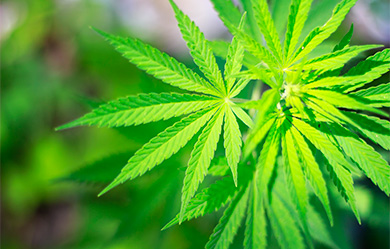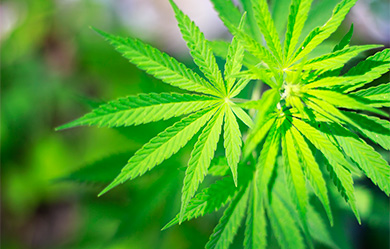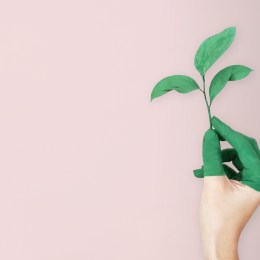
Unless you’ve been really, um, spaced out, you’ve heard about the wave of legalisation for medical and recreational marijuana use in the US – or in Uruguay, the first nation to legalise possession, coming ithis year.
You’ve also seen the buzz of media on how ramped-up legalisation has spawned an explosive (what they dub) ‘cannabusiness’ market, led by sophisticated ‘ganja-preneurs’ who are re-inventing who consumes marijuana and the many ways it can be used. Essentially, taking it from dorm room to boardroom, from plastic bag to Hermes bag, and from counter-culture to over-the-counter, with sleek dispensaries that are channeling Apple stores.
After decades of prohibition, marijuana is suddenly undergoing a makeover: more people worldwide view it as socially acceptable and medically important, and whole new markets and products are busily being invented. Once-lowly ‘weed’ has become a real industry, growing like weeds.
Spafinder Wellness 365’s Top 10 Global Spa and Wellness Trends Forecast* for 2015 has the lowdown:
Medical Evidence
Because cannabis has been long criminalised (legally equated with substances like heroin), both medical studies and pharmaceuticals have been held back.
Over 100 trials on medical cannabis exist (the vast majority positive), with the strongest evidence of benefit for nausea, wasting in AIDS and cancer, epileptic seisures, multiple sclerosis, glaucoma and chronic pain.
On the recreational side (for stress-reduction, help sleeping and so forth) the issue is ‘cannabis compared to what?’. Alcohol accounts for more health damage, deaths and violence than all illicit drugs combined, and people are far more likely to become dependent on alcohol than cannabis. And, according to a 2013 UCLA meta-review, even regular pot smokers have no greater risk of cancer.
The Decriminalisation Wave
The US has no lock on cannabis use: between 125-227 million people globally use it, with Africa, Oceania, Europe and North America having highest usage rates.
The cannabis legality map is a complex patchwork of ‘green’ (indicating those dozen nations where personal and/or medical consumption is either legal or decriminalised, like Canada, Norway, Peru, Portugal, Spain, Switzerland), even more ‘gray’ (nations where it’s technically illegal but tolerated, like across most of Latin America and Europe) and ‘black’ (firmly criminalised, like China).
But blanket prohibition is on the decline. In 23 US states medical marijuana is now legal, and Oregon, Alaska and Washington D.C. just joined Colorado and Washington in legalising recreational usage – unthinkable five years ago.
In 2016 many more states (like California, recreational) are expected to put it on the ballot. And NBC News recently stated that national US legalisation of marijuana is attaining ‘an aura of inevitability.’
Globally, everyone will be watching trailblazer Uruguay in 2015, the first nation to legalise possession for citizens.
Every week, you read about different national legislatures debating more legalization – from Austria, to Australia, to Colombia, to Jamaica (where activist associations list ‘wellness, travel and spas’ as some key markets ripe with opportunity). And even nations that mete out harsh punishments for possession are investing in the market. In fact, more than half the medical/wellness cannabis patents filed with the World Intellectual Property Office have come from Chinese companies.
Stress Salvation Seeking
Humans are crushed by unprecedented stress, and the desire to ‘re-set’ our toxically overloaded minds is fueling a rise in interest for both meditation and marijuana.
Many purists would reject the latter, but many mere, mortal humans prefer a little cannabis to the happy hour, Xanax or Ambien hangovers.
Almost every ‘stay’ spa serves wine – and wine and beer are of course slathered over people in treatments. So, if many wellness businesses will ‘say no’ to a THC cannabis connection (even though it’s natural, herbal ‘medicine’), others will ponder what that would look like with open minds.
”””Marijuana Remade
A key aspect of this transformation is in language, with ‘cannabis’ now replacing ‘marijuana’ as the more scientific, less historically-fraught term, as there are thousands of uses (from textiles to food) for this super-plant that has been used by humans for medicinal purposes for 8,000-plus years, with the modern prohibition representing the historical anomaly.
There are 66 unique chemical ‘cannabanoids’ locked within the plant (many with therapeutic uses), even if the world tends to narrowly associate it with just one, Cannibas Sativa with THC, the only component that actually produces a ‘high.’
In now-legal medical/ recreational markets, the way that psychoactive THC is getting delivered is being radically innovated: less healthy ‘pot smoking’ is being replaced with odorless new vaporiser pens (‘vape’ was Oxford Dictionaries’ 2014 ‘word of the year’) and with haute cuisine edibles that could grace a Bon Appetit cover. And non-THC cannabanoids are seeing new applications for problems like pain, anxiety, epilepsy, MS and other neurological disorders, and are the key ingredient in more and more topical lotions and beauty products.
Going High End
The global media delights in recounting the ways that cannabis is getting a classy re-branding in new commercial markets like the US.
You read about advertising agencies (see: Cannabrand) specialising in bringing ‘elite cannabis brands’ to professional, well-heeled consumers. You read about luxury cannabis tours in new recreational markets like Colorado and Washington state that pair tastings with ‘cannabis sommeliers’ with gourmet cooking classes, and a lot of spa-ing.
You read about new media dedicated to reviewing cannabis like fine wine: for example, the website Leafly, with its 70,000-plus strain and dispensary reviews (covering the US, Canada and Spain); or The Denver Post, the first mainstream newspaper to hire dedicated pot reviewers.
You read about companies like Dixie Elixirs (which, produces slickly branded edible products that would not look out of place on the shelves of Whole Foods) duking it out with Bob Marley’s estate’s new brand, Marley Natural, to become the global ‘Starbucks of cannabis’.
You read about new US reality TV shows (Pot Barons of Colorado or The Marijuana Show, a kind of ‘Weed Shark Tank,’ where entrepreneurs pitch canabusiness ideas), or about the new Chilean channel, Cultiva TV, educating on marijuana’s benefits to win national legalisation.
In Europe, you read about ‘cannabis social clubs’ blossoming in countries like Spain (700-plus clubs), London (75) and France (400), where marijuana sales are technically illegal but personal possession is not generally prosecuted.
In the global financial press, the tone is appropriately serious given the major capital investments happening in a market suddenly estimated to be worth $50 billion in the US and $200 billion worldwide.
Forecasting, Not Pronouncing
While the cannabis industry is working overtime to place all consumption in the ‘wellness column’, the opening up of commercial markets of the high-inducing variety certainly brings new problems.
Experts point out that psychoactive cannabis can be habit-forming and impact memory and other cognitive skills. They worry that a looming ‘Big Marijuana’ will lower prices and market intensely, luring in new users (including teenagers).
Proponents of open markets argue that global prohibition has failed spectacularly, creating a violent black market that puts billions in criminal hands, preventing useful medical research, and depriving people of the right to pursue a stress-reducing pleasure that is far less dangerous to their health than culturally-celebrated alcohol. They further argue that only commercial markets can ensure product quality and safety.
Given cannabis’ many uses and potential misuses (depending on who’s using it, how often, and why) there’s no way to ‘slot’ cannabis cleanly in either the wellness or not-wellness column.
It’s more complex, and the massive literature on that consideration can’t be summarised here. We’re reporting on (not pronouncing on the rightness of) the global needle tipping towards decriminalisation, and forecasting that the opening up of new markets will naturally create new intersections with spa/wellness.
The Cannabis Wellness Trend
For all the ink spilt on the cannabis ‘lifestyle’ makeover, there has only been piecemeal coverage of the ways that cannabis is becoming integrated with spa, yoga and beauty and wellness products.
When you imagine ‘marijuana and spa,’ things like ‘hot stoned massage,’ followed by an ‘exfoliating Doritos scrub’ rush to mind (talk of marijuana seems to spawn nervous jokes).
But while new models are making the former possible, the fact is that the cannabis and spa/wellness connection is taking diverse, more serious forms. am i high, or is This a Spa? It’s striking how intensely cannabis businesses yoke themselves to the familiar language of ‘health and wellness.’
Scanning thousands of dispensaries, you’re hit with names like Mindful (a Colorado dispensary network), Wellness Caregivers (Los Angeles) and Pure Wellness (Ohio).
Mission statements typically align with Harborside Health Centres (Oakland ans San Jose, California): a ‘dedication to changing the perception of cannabis to one of wellness and healing’.
And if one rising cannabis store design trend is ‘Apple Store’, the more prominent look is ‘spa’: warm, aspirational, wellness-clinical, with smartly dressed women ‘budtenders.’
Many dispensaries, like Capital Capital City Care (Washington DC), report that their look has been very consciously designed to be ‘cross between a spa and doctor’s office’.
Dispensaries and Clubs add Massage, Yoga, Fitness
A trend to watch is more North American dispensaries and European cannabis clubs adding free massages, yoga/Pilates/meditation classes, alternative medicine specialists – and even (cannabis) juice bars – to morph into a new kind of ‘Bliss Spa’.
At Canna Clinic Medicinal Society there are free cannabis oil massages, while Sea to Sky Alternative Healing Clinic (both Vancouver, Canada) has an in-house naturopath and ‘medicinal’ smoothie bar.
At Sparc (San Francisco) you’ll find free acupuncture, meditation, acupressure, Ayurveda and live jazz.
More European cannabis clubs, like Barcelona’s AIRAM and LA MARIA, offer members massage, medical consultations and yoga and Pilates classes.
Consider Harborside Health Centre’s wellness menu: their 100,000 customers have access to free qi gong, tai chi, yoga, reiki, meditation and TCM, along with chiropractors, naturopaths, hypnotherapists and western herbalists.
Are these ‘spas’? If not, are they competitors to spas (with an advantage of being cost-free)? Adopting the look and menus of spa/boutique fitness is one smart move, reassuring patrons that these are places of safety, community and healing.
Med Spas Prescribe
Another trend is traditional medical spas having clinic doctors recommend or prescribe for medical marijuana – like Restorations Wellness Centre and Spa (Denver) and MD Medical Spa and Wellness Centre (Boston and Cape Cod, Massachusetts) – after which topical cannabis products can be used in spa services.
Cannabis and Spa Tourism
For 40 years Amsterdam, with its hundreds of ‘coffee shops,’ has been Cannabis Tourism Central (although it’s technically not even legal there, just tolerated).
And the Internet lights up with global guides on the best worldwide destinations to ‘smoke weed’, like Morocco’s Rif Mountains or Spain’s burgeoning cannabis clubs (technically for resident ‘members’ but in reality giving Amsterdam a run for the cannabis tourism crown).
However, with marijuana legal in four naturally beautiful US states – Colorado and Washington (2012), Oregon and Alaska (2014), and Washington, D.C. poised to legalise the recreational usage, a new model was born: fully legal cannabis tourism open to ‘medical tourists’ (without access at home) as well as those seeking what is for them a special kind of experiential ‘wellness trip.’
If you think it’s all buses filled with university students, think again: very high-end tours are emerging, creating luxe experiences on the ‘wine country’ model.
For instance, Colorado tour operator SPIRO offers a Rest and Relaxation package with luxury transport to Denver, four-star hotel stays, trips to farms, cooking classes, art museum outings, and massages (with THC-infused oils) at fine day spas.
Or consider So Mile High’s $38,000/couple Colorado tour, with private jet, the option of Ritz-Carlton accommodations, very fine dining, and a whole day at Antoine Du Chez, one of Denver’s toniest spas.
There are new guides identifying the growing number of hotels that allow guests to partake in rooms/ dedicated spaces, and an attractive property like Adagio Bed and Breakfast recently re-branded itself as Bud and Breakfast.
What’s the impact of recreational legalisation on tourism numbers? It hasn’t yet been formally quantified in those US states, but it seems significant, if hardly a case of people jumping on red-eyes for Reefer Madness.
Colorado had a record tourism year in 2013, and a 2014 study found that out-of-state visitors account for 44 percent of marijuana sales in larger cities and up to 90 percent in mountain resorts.
Interestingly, Colorado tourism officials report that most cannabis tourism is of the ‘secondary’ variety: not the main purpose of the trip, but something people choose to experience while there. But with more US states poised to legalise, the London Guardian recently pronounced, ‘It must only ”””be a matter of time before you can book a marijuana tour of the entire US – yoga and chocolate brownies included’.
Denver-based TtravelTHC, a website that connects tourists to private, ‘marijuana-friendly’ vacation rentals in Colorado, will officially launch this month. The company helps visitors to Colorado take advantage of the state’s new marijuana legislation, which makes the purchase of marijuana legal but prohibits smoking of cannabis in public places. (Most hotels also do not allow smoking of any kind, which leaves tourists who would like to smoke in a quandary).
TravelTHC co-founder Jordan Conner says the company plans to expand its short-term rental offerings as marijuana is legalised in other states and countries.
‘Our goal is to be the online destination for people who would like to smoke cannabis safely and legally in the comfort of a private home,’ he says.’
Profusion of Topical products
As applications for the many non-high-inducing cannabinoids get developed, a wave of cannabidiol (CBD-infused) lotions, massage oils, salves, salts, soaps, and beauty/skincare products are appearing.
While there’s the double bind that not much research has been done (because topical CBD/low-THC products are, oddly still classified as illegal beyond the medical dispensary), there are indications that these new topicals have pain-reducing and anti-inflammatory benefits.
And because they’re packed with essential fatty acids and anti-oxidants they’re a hot new super-oil for dry skin, acne, eczema and psoriasis.
There are two ‘hemp’ topical classifications: lotions and potions that use hemp seed oil and are available to all, like hemp skincare pioneer Body Shop products, or newer players like Hempz or Cannabis Beauty Defined.
CBD-infused products, with their small amount of THC, are only available where medical marijuana is legally dispensed or in new recreational markets.
A few major players: Apothecanna (founded by a product designer for natural companies like Aveda), with its pain relieving, calming, and stimulating body cream line; or Mary Jane’s Medicinals, with its oils, lotions, soaps and bath balls; or Doc Green’s healing creams.
These companies’ sites are full of glowing reviews on these products’ power as pain relievers and skin beautifiers, and it seems only logical that looser regulations for topical products must be on the horizon.
The Cannabis Spa
We’ve examined the spa-cannabis connection in tourism, and in dispensaries that have added massage and wellness services, but the biggest ‘cannabis connection’ for regular spas is using the new, won’t- get-you-stoned topicals in bodywork and facials.
It’s still complex, because clients either need to bring in their own legally purchased products, or spas in legal markets need to partner with companies like Apothecanna to deliver new cannabis treatments.
For instance, LoDo Massage and Yoga (Denver) says they’ve tripled their business since they launched the pain-relieving Mile High Massage with Apothecanna’s lotions.
Cannabis spa treatments are also happening in Europe: German spa guide Wellness Heaven recently tested diverse treatments like the Cannabis Sativa oil massage at Therme Laa Hotel and Spa in Austria.
There’s a reason that companies like HempMeds (which sells $1 million in CBD-infused products a month) has sponsored the International Spa Association (ISPA) convention: these companies see spas as a key future market.
New models are coming. Primal Wellness (Denver) just opened ‘the world’s first cannabis day spa’, where the whole focus is cannabis bodywork and facials.
And it’s telling that one of the first contestant- entrepreneurs on The Marijuana Show presented a Green Spa concept, a cannabis-focused property with massage, hot tubs and private camping – geared to Asian tourists.
”””Ganja Yoga
Anyone that’s taken yoga classes may have thought at some point, are some of these people stoned?
But whatever has been unofficially going on (counterculture ’60s celebs like the Beatles and Allen Ginsberg publicised their yoga and cannabis experiments), it’s now coming out into the open.
More instructors are accepting of the pairing, and more branded classes are appearing, dubbed ‘enhanced yoga’, ‘420 Remedy Yoga’, or ‘Ganja Yoga’. Proponents will cite that ancient Indian Vedic texts mention that cannabis enhances yoga, quieting the outside world.
Examples of trending cannabis yoga classes: pioneer Dee Dussault, uns Ganja Yoga classes in San Francisco, where students can ‘enhance’ during class if they bring their medical card, and where 15 minutes are spent imbibing, followed by 90 minutes of relaxing hatha practice.
At Atwater Yoga (Los Angeles) there are regular ‘420 Remedy’ classes, and you can partake in ganga yoga at the House of Yoga (Toronto). European Cannabis clubs, like Cannabis Club London, are offering the combo, and Cannabrand rolled out a Vape and Vinyasa class in Colorado.
Purists argue that true yogis should keep a clean mind, while proponents will counter that cannabis helps people focus on their breath and meditation.
It’s for people to decide, but they will certainly have more places to experiment in legal/tolerant markets.
Cannabis Edibles: Am I Stoned, or is This a Trendy Food Shop?
A mind-blowing cannabis edibles market is taking off, and the haute cuisine delicacies are as much the star as the ‘high’ cooked within – a built-in solution for the ‘munchies’.
The Sterling Rice Group named edible marijuana products one of the top 10 2015 food trends, with THC-infused cannabis getting rolled into every imaginable trendy food/beverage, as newly legal markets meet the Foodie Revolution.
The Colorado Chamber of Commerce claims that edibles make up 45 percent of the legal cannabis market, and the lowly home-baked pot brownie is getting replaced by Parisian macaroons, ice cream and cold-brewed coffee.
Colorado’s Sweet Grass Kitchen churned out mini pumpkin pies and spice teas for Thanksgiving; Dixie Brands wants to create a marijuana soda revolution (served up in suave brushed-aluminum bottles); and Denver’s Love’s Oven is concocting croissants, maple bacon bars and olive oil, with the LA Times reporting the owner wants to become the ‘Escoffier of marijuana’ (referencing the famed French chef).
A””” Superfood
We’ve had a parade of ‘it’ seeds (flax, chia, etc.) and ‘it’ milks (almond, kefir, etc), but hempseed and hemp milk are the new buzzed-about superfoods, with very public fans like Dr Oz (hemp milk is his favourite alt-milk) and Dr Andrew Weil arguing that they’re some of the most uniquely nutritious foods on earth.
Both the seed and the sweet, nutty milk are a complete protein, packed with all ten essential amino acids, fibre, vitamin E, iron, magnesium and zinc, with no known allergens.
People are tossing seeds in salads, blending hemp powder in smoothies, even juicing hemp now.
And there are more hemp milk brands, from Living Harvest to Hemp Bliss, on the shelves.
The Future
Perceptions of cannabis – applications for the ‘whole-plant’ and a global wave towards more medical and recreational legalisation – are just at a tipping-point.
Legalisation creates boom markets overnight, and in the US a ‘wild west’ of start-ups (like the internet’s early days) is rushing to create new business models, including tourism, therapeutic products, foods – and, yes, new spa, yoga and wellness ‘connections.’
The world will closely watch the North American and Uruguayan experiments in what works, what doesn’t. But this is not just a ‘2015’ trend, it’s one with a long, gradual future.
If more US states legalise use as expected, will the US government legalise at a national level? And when viable national and international markets become a reality, will big pharma and mega-corporations step in and take over?
According to recent articles in Scientific American and Newsweek there’s new research/interest in how psychoactives like cannabis, and more intense psychedelics like ‘magic mushrooms,’ peyote and LSD, ‘could revolutionise healthcare’.
For now, wellness ‘purists’ (whether businesses or consumers) will likely embrace the new therapeutic topicals and hemp as superfood, while they shy away from the psychoactive, ‘rest and relaxation’ uses of cannabis in a spa, yoga or travel setting. Others will welcome all of these developments.
Cultures of purity and open-mindedness will sharpen, and for the latter, there will be more new intersections between cannabis – and spa, wellness and yoga – in more places, in years to come.
NOTE: Spafinder Wellness 365 is reporting on (not advocating for or against) the legalisation of cannabis. They are forecasting that when legal markets for use open up, new intersections with spa/wellness will be created. Marijuana use is still illegal in most nations, and this trend covers only those countries/regions where legal change has happened, or is underway.
About Spafinder Wellness 365 and its Top 10 Global Spa and Wellness Trends Forecast
Spafinder Wellness 365’s goal with the annual Trends Forecast is to provide the insight and information companies in the wellness industry will need to make sound decisions in the year ahead – and help businesses, consumers and the media understand how economic, cultural and social shifts will impact not only our industry, but also people’s lives.
In the sea of trend lists appearing each new year, we think our unique forecast stands out, taking an intense, research-driven view of what’s trending across the global wellness landscape from spa experiences to fitness, beauty, travel, nutrition and even workplace wellness. And unlike a standard slideshow, our 70-plus page report dives deep into the why, how and where each trend is developing.
The 2015 Spa and Wellness Trends Forecast is developed by a team of research analysts, editors and industry experts, and is based on ongoing surveys of the 20,000-plus spa, wellness and beauty providers in the Spafinder Wellness 365 Network, thousands of travel agents and hundreds of thousands of consumers – as well as interviews with industry leaders and extensive analysis of current market research.




